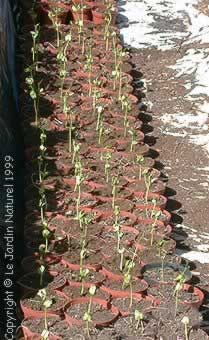

GENERALITIES
Easy to grow, baobabs are suitable as bonsai or indoor plants as well as outdoor plants (in tropical or subtropical countries in that case).
There are 8 species of baobabs or baobab-trees (genus Adansonia):
- 6 endemic to Madagascar : Adansonia grandidieri, Adansonia madagascariensis, Adansonia perrieri, Adansonia rubrostipa (= Adansonia fony ), Adansonia suarezensis, Adansonia za
- 1 species endemic to Africa : Adansonia digitata
- 1 species endemic to Australia : Adansonia gibbosa (= Adansonia gregori ).
The malagasy baobabs occur generally in deciduous forests in the half west part of the island. Some areas are appropriately named " baobab forests " because the baobabs constitute the dominant tree species.
Concerning the interaction with animals and with humans, the ecological role of baobabs is very important.
Baobabs are small (3m) to large (30m) trees with massive trunks and compact crowns.
The forms of the trunks are variable, from bottle-shaped to tapering or cylindrical or irregular.
But baobabs are very distinctive from other trees and easily recognizable.
Their bark is smooth and the wood is fibrous and soft, stocking water for the long drying periods.
The baobabs are deciduous trees, without leaves for many months. That is an explanation to the common name "upside down tree".

THE 9 SPECIES OF BAOBABS
Adansonia digitata
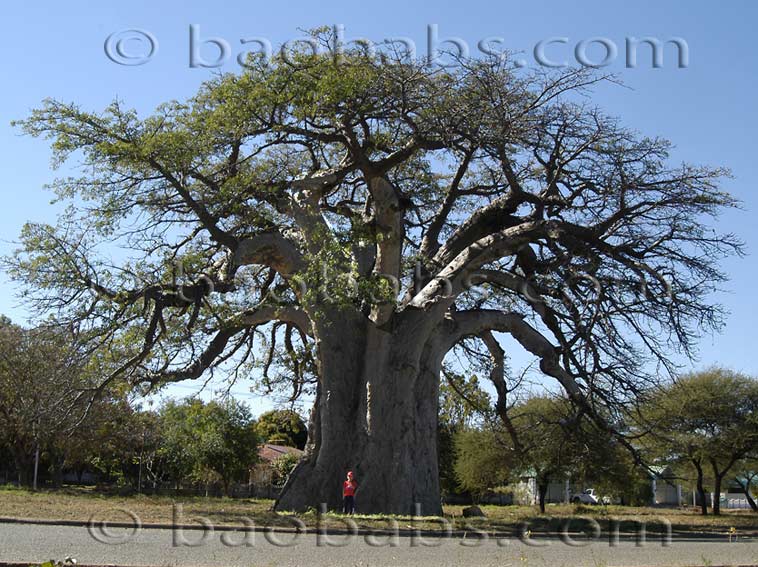
The African baobab is the most important babobab-tree in number and also the better known among the 9 species.
Unlike the 7 other diploid species, it is tetraploid.
This means that it has 4n chromosomes in its cells, the diploid number of 2n being the normal number.
It is indigenous in the semi arid part of the sub-Saharian Africa.
It is clear that the distribution of the species throughout the dry parts of Africa is mainly due to humans.
Adansonia digitata has a character which is unique in the genus: the flowers are pendulous .
The tree is usually massive, reaching 25m in height and up to 12 m in diameter, with an irregular crown.
The bark is grey, smoth, some times irregurlarly tuberculate.
The flowers of Adansonia digitata are white.
The fruits are variable, globose to ovoid.
Adansonia gibbosa ( = Adansonia gregorii )
The Australian baobab is a small (rarely taller than 10m ) irregularly shaped tree often with multiple trunks, and irregular crown.
Bark grey, smoth.
It is restricted to the north western area of Australia
The flowers are white to pale cream
Fruit globose to ovoid.
Adansonia grandidieri

One of the six species of baobabs endemic from Madagascar, perhaps the better known of Malagasy baobabs, and for a lot of people, the most aesthetical of all baobabs. A pure gem.
Often represented on the front cover of books dealing with Madagascar.
Occuring near Morombe and Morondava in the west part of Madagascar
Large trees up to 25m tall and 3m diameter of trunk which is usually unique and cylindrical
The crown is at the top of the tree and flat; the branches are regurlarly distributed, mainly horizontal.
Bark reddish grey, smoth.
Flowers are white, yellowing whith age.
Fruits are subglobose to ovoid with a reddish indumentum. The pericarp is thin and fragile.
Adansonia madagascariensis

Grows in dry or moist forests in the Mahajanga province and also in the North of Madagascar.
Small to large baobabs (5 to 20m) with variable shapes of trunks from bottle to cylindrical and irregular crown.
Bark smoth, pale grey.
Flowers dark red.
Fruits globose to subglobose, small (almost 10-15 cm long) and broad. Indumentum brown and sparse.
IMPORTANT NOTE: Most of the seeds of Adansonia madagascariensis proposed for sale on the web ARE NOT Adansonia madagascariensis but Adansonia grandidieri... This is due to a confusion: The seeds are collected in the habitat from a group of Adansonia grandidieri which are located in the south of Madagascar and unknown as grandidieri so confused with A.madagascariensis. This confusion is also due to the fact that the shapes of the fruits of A.madagascariensis are similar to those of A.grandidieri.
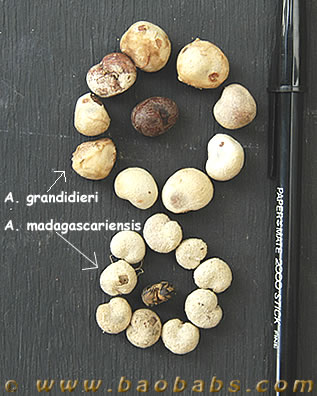
About seedlings, the difference is evident concerning the shape of cotyledons and first leaves :
- A.grandidieri: cotyledons are short, thick and wavy. First leaves are thin and irregular, and quickly new leaves are subdivided in leaflets
- A.madagascariensis: cotyledons are large, thin and flat. First leaves are generally long and simple, with a shiny deep green color, and new leaves often stay simple for many months.
We are proud to offer to our customers seeds of verified species, this for all species that we propose for sale on our web site.
Adansonia perrieri

Perhaps the most endangered species of baobab.
Less than 10 populations are actually known.
Restricted to the North of Madagascar near Antsiranana.
Medium to tall trees up to 30m.
Irregular crowns with thick branches, often ascending at 45°.
Flowers pale yellow to yellow orange.
Fruits up to 30cm.
Adansonia rubrostipa ( = Adansonia fony )

The "smallest" baobab of Madagascar.
Usually small (4-5m) but can reach 20m sometimes.
The trunk is bottle shaped with a distinct constriction beneath the branches.
The crown is irregular.
Bark is usually redish brown when mature, but grey and rugous when young.
Easily recognizable when young by the serrate leaves.
Flowers bright yellow to orange yellow.
Fruits globose, with a dense reddish indumentum.
Adansonia suarezensis

Restricted to the north of Madagascar near Antsiranana.
It can be considered as an endangered species of baobab.
Large trees up to 25m tall and 2m in diameter.
Trunks single, often tapering from bottom to top.
Crown flat-topped, branches regularly distibuted and mainly horizontal.
Flowers white
Fruits irregular, long.
Seeds big (about 450/kg)
Adansonia za
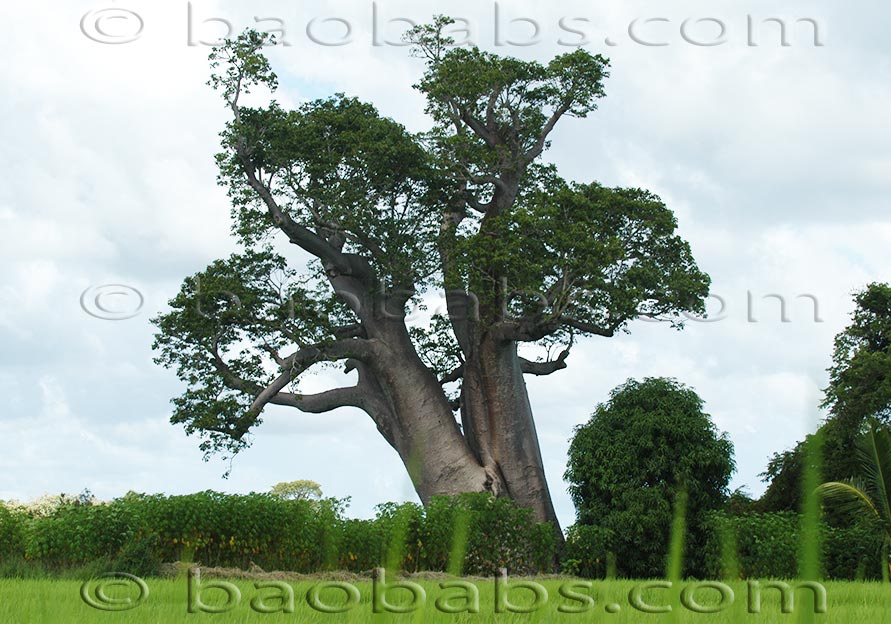
The most widespread baobab of Madagascar, occuring in south, west and northwest.
5 to 30m tall, usually single trunk, cylindrical or slightly tapering and swelling.
Primary branches often tapering and ascending.
Bark grey.
Flowers yellow.
Fruit ovoid or oblong, 10 to 30cm, usually black.
Germination phanerocotylar.
CULTIVATION OF BAOBABS
The Baobabs (genus Adansonia) are hardy tropical plants and so easily suitable as indoor plants or bonsai plants .
Depending of the species cultivated and the conditions of cultivation, they are often dormant and without leave for a part the year.
The seeds are reniform, generally about 12-14 x 10-12 x 9-10 mm, excepted for seeds of Adansonia suarezensis which are bigger.
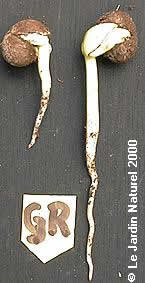
The sowing is in fact simple and easy. But the germination can be eratic, either occuring quickly with a good ratio or long with a bad ratio.
It depends of the temperature and humidity of the soil, and certainly of other parameters which are not well known.
Generally in good conditions, seeds germinate after a week to 10 days.
Place the seeds in a pot in half soil half humus; cover the seeds with about 1.5cm of the medium, water it every day and wait...
After some days the seeds germinate, the two cotyledons can be fleshy (ex. Adansonia grandidieri) or flat (ex. Adansonia za).
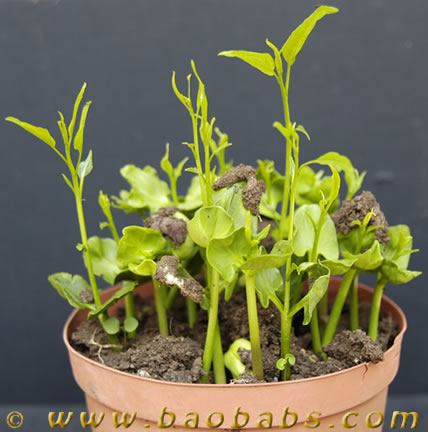
The fact that the first "true" leaves are foliolate or not is variable, even upon a single species, I think that it also depends of the conditions of cultivation. But generally, the frist leaves are not foliolate
The Adansonia species are generally easy to grow in pots as indoor plants or bonzai and are resistant to dryness. They are quickly developping an underground caudex.
They are some notable differences between the species concerning growing speed.
Adansonia gibbosa (the Australian baobab) is very slow and extremely sensible to rot and demand high temperatures for growing.
At the other side, Adansonia digitata ( the African baobab) is fast growing and well resisting to rot attacks.
The medium for cultivation must be well draining and I suggest to add some river sand to the mixing of half humus half soil.
The plants can be well watered during the hot season and soil must be kept quite dry during the dormance which occurs generally from the end of summer to spring.
